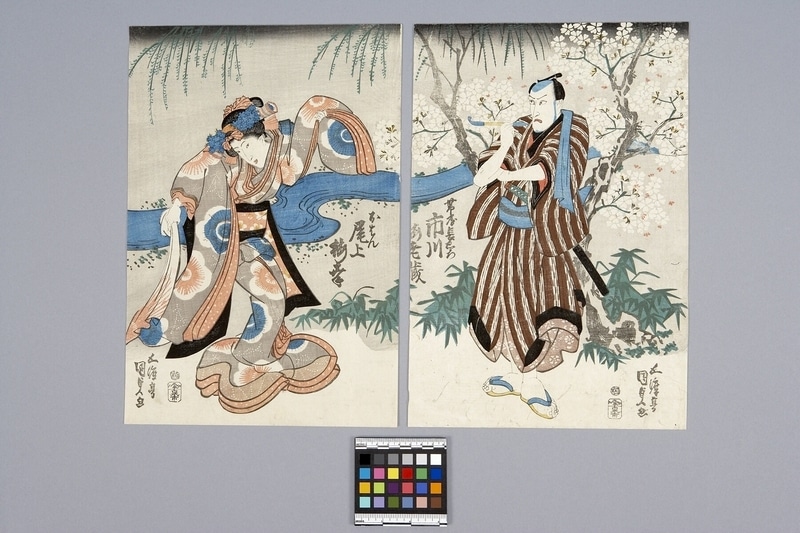Obiya Chōemon, Ichikawa Ebizō; Ohan, Onoe Baikō Item Number: N2.1164 a-b from the MOA: University of British Columbia

Description
Two piece woodblock print of kabuki actors, a man (part a) and a woman (part b), with white cherry blossom trees and a blue river in the background. The woman is on the left sheet and has her head tilted down to the left. Her hair is elaborately done up with a variety of accessories. She is wearing clothing that has orange-pink and blue flowers print on a grey background. The man (part a) is on the right sheet and has his right elbow resting on his left wrist as his right hand holds a pipe. He is facing the woman and is wearing clothing that has a brown striped pattern. Each inner side has the title (consisting of the names of kabuki characters and actors) in black, written in ‘kanji’. Each lower outer corner has a circular black censor seal known as kiwame-in (極 印), a vertically rectangular black seal of the publisher (版 元, hanmoto), and the artist’s signature in black, written in ‘kanji’. The print is made of two vertically rectangular pieces, creating a horizontally rectangular image overall.
History Of Use
The date made refers to the date the design of this print was originally created, shortly after this kabuki play, “Gochiūmon Shusu no Obiya” (御注文繻子帯屋) had been performed on March 5, 1840. This print is likely to be an early impression/edition as indicated by the censor seal on this print, 極 (kiwame). Literally meaning, “approved”, this particular type of censorship seal was used on woodblock prints issued during the period 1791-1842, and indicates that the print had passed inspection by the Edo (modern day Tokyo) magistrate officials. It was published Izumiya Ichibei (和泉屋市兵衛) as indicated by the publisher’s seal.
Narrative
On both sheets: signed 五渡亭国貞画 (Gototei Kunisada ga); censor seal (circle): 極 (kiwame), and the publisher’s seal (rectangular): 本、泉市 (Hon, Sen’ichi). On the right sheet: 帯屋長右衛門 (Obiya Chōemon) – the name of a kabuki character, and 市川海老蔵 (Ichikawa Ebizō) – the name of a kabuki actor. On the left sheet: おはん (Ohan) – the name of a kabuki character,and 尾上梅幸 (Onoe Baikō) – the name of a kabuki actor.
Specific Techniques
Nishiki-e (錦絵, “brocade picture”), a type of multi-coloured woodblock printing, often used in the ukiyo-e (浮世絵, “pictures of ‘floating world’”) genre of Japanese art.
Item History
- Made by Kunisada Utagawa (Maker) in Tokyo, Japan during 1840
- Collected during 1914
- Owned by James Fyfe-Smith and Mary G. Fyfe-Smith
- Owned by Florence Fyfe-Smith before 1957
- Received from Florence Fyfe-Smith (Donor) during 1957
What
- Name
- Obiya Chōemon, Ichikawa Ebizō; Ohan, Onoe Baikō
- Identification Number
- N2.1164 a-b
- Type of Item
- Manufacturing Technique
- woodblock printed
- Overall
- height 36.6 cm, width 49.9 cm
- Part A
- height 36.6 cm, width 25.0 cm
- Part B
- height 36.6 cm, width 24.9 cm
Who
- Culture
- Japanese
- Creator
- Kunisada Utagawa (Maker)
- Previous Owner
- James Fyfe-Smith, Mary G. Fyfe-Smith and Florence Fyfe-Smith
- Received from
- Florence Fyfe-Smith (Donor)
Where
- Holding Institution
- MOA: University of British Columbia
- Made in
- Tokyo, Japan
When
- Creation Date
- during 1840
- Collection Date
- during 1914
- Ownership Date
- before 1957
- Acquisition Date
- during 1957
Other
- Item Classes
- works on paper
- Condition
- good
- Current Location
- Case 79